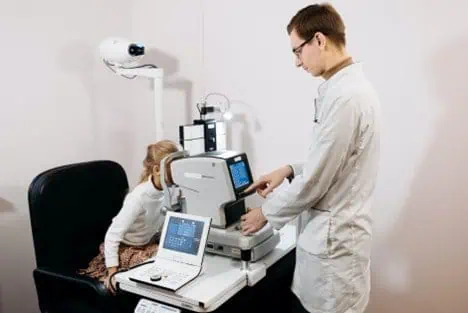On This Page[Hide][Show]
Brown syndrome is a rare eye condition that affects eye movement. It occurs when there is an issue with the muscle or tendon that controls the eye’s movement, making it difficult or even impossible to move the eye in specific directions.

This condition can impact vision, although nothing is wrong with the eye. Symptoms may include difficulty moving the eye upwards and inwards, leading to potential vision problems. Our team has experience managing claims related to Brown syndrome and serves claimants nationwide. Contact us online or call (888) 321-8131 for a free case review.
This blog post will delve into the causes, symptoms, available treatments for Brown syndrome, and what to do if your condition prevents you from working and you need to file a long-term disability claim. Whether you are personally dealing with Brown syndrome or seeking information for a loved one, gaining insight into this condition is essential.
What Is Brown Syndrome?
Brown syndrome, named after the ophthalmologist Harold W. Brown, who first described it, is a rare eye condition. It is characterized by limited eye movement, particularly the upward and downward motion. This condition occurs when the superior oblique tendon, a small muscle that helps control eye movement, becomes restricted.
As a result, individuals with Brown syndrome may have trouble moving their eyes upward, especially when looking toward their nose. This limitation can impact everyday activities such as reading, writing, and driving. In the most severe cases, it may affect a person’s ability to work.
Causes of Brown Syndrome
Most incidences of Brown syndrome are congenital. It may also occur later in life due to other health conditions.
Congenital Brown Syndrome
The exact cause of most cases of congenital Brown syndrome is not entirely understood. This condition may occur due to the shortening or thickening of the tendon sheath of the superior oblique muscle, which restricts its movement. Additionally, some rare cases of Brown syndrome have been reported to be inherited as an autosomal dominant genetic trait. This means that a single copy of the disease gene, received from either parent, can result in the appearance of the disease. The risk of transmitting the disorder from affected parent to offspring is 50 percent for each pregnancy, regardless of the sex of the resulting child.
Acquired Brown Syndrome
Acquired Brown syndrome may develop because of trauma, surgery, or inflammation due to an underlying disorder such as lupus, rheumatoid arthritis, or Sjogren’s syndrome. Infections and eye conditions that cause inflammation can also lead to Brown syndrome. Additionally, traumas that cause damage to the face and eyes, such as eye injuries, facial fractures, and complications after eye surgery, can result in Brown syndrome.
Symptoms of Brown Syndrome
In most cases, Brown syndrome impacts just one eye and is more likely to affect the right eye. However, it affects both eyes in roughly 10% of people diagnosed with this condition.
Generally, the symptoms of this condition restrict regular eye movements and vary in severity. Specific symptoms of Brown syndrome may include:
- Inability to look up to the left with the right eye.
- Inability to look up to the right with the left eye.
- Possible pain when attempting to look up.
- Partial or complete inability of the eyes to move toward or away from the center.
- Misalignment of the affected eye compared to the healthy eye, especially when looking up.
- Widening of the eyes when looking upward or tilting the head backward.
- The affected eye appears to be looking downward, even when looking straight ahead or upward, and
- Droopy eyelids.
Diagnosing Brown Syndrome
To properly diagnose Brown syndrome, an eye care specialist will conduct an eye exam, evaluating the range of motion in both eyes and observing any limitations in upward gaze. They will also rule out the possibility of other eye disorders contributing to your symptoms.

Examination Procedures
One of the primary examination procedures for diagnosing Brown syndrome involves observing the patient’s eye movement during different gazes, particularly upward and inwards. This can help the specialist determine the extent of restricted eye movement and pinpoint specific muscle or tendon involvement areas.
Another critical aspect of the examination involves assessing any pain or discomfort experienced by the patient when attempting to move their eyes in specific directions. This can provide valuable insight into the underlying issues causing Brown syndrome.
Role of Eye Care Specialists
Eye care specialists play an integral role in the diagnosis of Brown syndrome. Their expertise allows them to thoroughly evaluate the patient’s eye movements, identify abnormalities or restrictions, and determine the most appropriate action. With their specialized knowledge and diagnostic tools, eye care specialists can accurately diagnose Brown syndrome and devise tailored treatment plans to address it effectively. Your specialist will also play a critical role in any disability claims for Brown syndrome.
If you believe you were wrongfully denied long-term disability insurance, contact Ortiz Law Firm today. We can help you understand the options available to you.
Treatment Options for Brown Syndrome
Treatment for Brown syndrome varies depending on the severity and underlying cause of the condition. There are non-surgical treatments and surgical intervention options for managing Brown syndrome. Acquired cases of Brown syndrome can also be treated by addressing the underlying condition.
Non-Surgical Treatments
Non-surgical treatments for Brown syndrome focus on addressing symptoms and alleviating discomfort. This may include:
- Eye Exercises: Eye exercises and vision therapy supervised by an eye care specialist can help improve eye coordination and reduce symptoms.
- Prism Eyeglasses: These specialized glasses can help manage double vision and improve the eyes’ alignment.
Surgical Interventions
In cases where non-surgical treatments are ineffective, surgical interventions may be considered. Even with surgery, the condition may reappear. Surgical options for Brown syndrome include:
- Tendon Expansions: Lengthening the restrictive superior oblique tendon can improve eye movement and reduce the restrictions present in Brown syndrome.
- Tenotomy: This procedure involves cutting the superior oblique tendon to alleviate the limitations on eye movement.
- Cyst Removal: If a cyst is causing your symptoms, a surgeon can remove it.
Treating Inflammatory Brown Syndrome
If inflammation around your eye is caused by an autoimmune disease, infection, or trauma, addressing the underlying cause will typically also address the symptoms of Brown syndrome.
Your healthcare provider will recommend treatments based on the specific cause of the inflammation. You will likely require medication to help reduce the inflammation in your superior oblique muscle. The most common medications used to treat Brown syndrome include:
- Over-the-counter NSAIDs such as aspirin, ibuprofen, and naproxen help relieve pain and reduce inflammation.
- Corticosteroids, which your provider may inject directly into your superior oblique muscle.
- Immunosuppressants may be prescribed to prevent your immune system from harming healthy cells and tissues.
Claiming Disability Benefits for Brown Syndrome
Brown syndrome can impact vision by causing limited or restricted eye movement, particularly while looking upward. This limitation can lead to double vision, which makes it challenging to focus and see objects. Individuals with Brown syndrome may also experience discomfort or strain in their eyes due to the restriction in movement. This can impact daily activities such as reading and driving and may even disrupt a person’s ability to work.
It can be challenging to navigate the process of applying for disability benefits. Still, it’s an essential step for individuals with Brown syndrome who cannot work due to their condition. Here, we’ll explore the steps to file for disability benefits and what to do if your claim is denied.
Get a free case review now to determine if a long-term disability attorney at Ortiz Law Firm can help you pursue the benefits you deserve.
Filing for Long-Term Disability (LTD)
To file for long-term disability insurance benefits, first obtain the necessary claim forms from your insurance provider. Complete the forms accurately and thoroughly, providing all requested information and supporting documentation, such as medical records and physician statements. Submit the completed forms and documentation to the insurance company within the specified time frame. Keep copies of all documents for your records. Be proactive in following up with the insurance company to ensure your claim is processed promptly.
What To Do If Your LTD Claim Is Denied
If your long-term disability insurance claim for Brown syndrome is denied, you should immediately request a copy of your claim file from the insurance company. Carefully review the denial letter and the policy to understand the reason for the denial. Consider consulting with an attorney specializing in disability insurance claims to evaluate your options and assist with an appeal. Be mindful of any deadlines for appealing the denial, gather all relevant medical and vocational evidence, and then submit a comprehensive appeal.
Request a Free Case Review to Discuss Your Disability Claim for Brown Syndrome
If you cannot work due to Brown syndrome and the necessary treatment, you may be eligible to receive long-term disability insurance benefits. Understanding Brown syndrome and its causes, symptoms, and treatments is crucial for effectively managing your condition and filing a successful disability claim.
By being well-informed about the condition’s effects and implications, claimants can present compelling cases supported by medical evidence and expert opinions, increasing their chances of a successful outcome. However, you will likely face challenges in the claim process.
If your disability claim for Brown syndrome is denied, it is recommended that you consult a long-term disability attorney promptly. We have experience handling claims involving Brown syndrome and represent claimants nationwide. Call (888) 321-8131 for a free case review.
Sources
- Web MD. “What Is Brown Syndrome?” Retrieved from (https://www.webmd.com/eye-health/what-is-brown-syndrome) Accessed on December 12, 2023
- Cleveland Clinic. “Brown Syndrome.” Retrieved from (https://my.clevelandclinic.org/health/diseases/24195-brown-syndrome) Accessed on December 12, 2023
- National Organization for Rare Disorders. “Brown Syndrome” Retrieved from (https://rarediseases.org/rare-diseases/brown-syndrome/) Accessed on December 12, 2023
- News Medical. “What is Brown Syndrome?” Retrieved from (https://www.news-medical.net/health/What-is-Brown-Syndrome.aspx) Accessed on December 12, 2023
